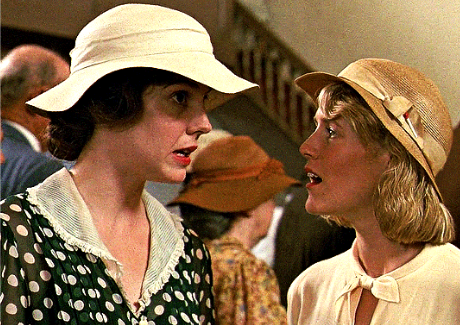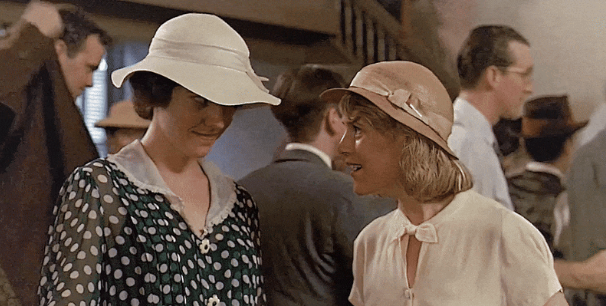
The Gentle Force at the Center of the Storm
Among the unforgettable characters in Fried Green Tomatoes, Ruth Jamison stands apart—not because she’s the loudest or most flamboyant, but because she is the still center around which so much emotional transformation revolves. Played with haunting tenderness by Mary-Louise Parker, Ruth is the embodiment of quiet courage. She is a woman whose strength is not in rebellion, but in steadfastness. Not in defiance, but in love.
Though Idgie Threadgoode’s fiery spirit often takes the spotlight, it is Ruth who brings balance, depth, and vulnerability to their story. Her journey—from an obedient daughter and abused wife to a woman who chooses love, community, and self-respect—is one of the film’s most profound emotional arcs. Her softness is not weakness; it is her greatest source of power.
A Life of Silent Suffering
When Ruth first appears in the film’s 1920s timeline, she is living a life that is all too familiar to many women—trapped in a marriage built on fear, isolation, and violence. Her husband, Frank Bennett, is emotionally and physically abusive, and Ruth, bound by religious and social expectations, endures in silence. Her face wears a mask of politeness, but beneath it lies deep sorrow and anxiety.
It’s important to note that Ruth’s character is not simply defined by her victimhood. She is a deeply devout, morally grounded person who values kindness and loyalty. But she has been taught that endurance is virtue, and that suffering is her cross to bear. It’s only when she receives a letter from Idgie—written with urgency and love—that something inside her begins to stir.
Ruth’s decision to leave Frank and return to Whistle Stop is her first act of defiance, and it changes everything.
A Love That Dares Without Labels
Much has been written about the relationship between Ruth and Idgie. While the film, released in 1991, stops short of explicitly labeling their connection as romantic, it is clear to any discerning viewer that their bond transcends friendship. From the way they look at each other to the life they build together, Ruth and Idgie are soulmates in every sense.
Their love is not defined by physicality, but by profound emotional intimacy. Ruth’s decision to leave her abusive marriage and raise her child with Idgie is nothing short of radical—especially in the deeply conservative South of the 1920s. It is a quiet revolution.
Ruth never proclaims her love aloud, but her every action is filled with devotion. When she touches Idgie’s hand, when she chooses her over Frank, when she builds a home and life with her—it is love in its purest, most selfless form.
Rebuilding Life Through Care and Community

At the Whistle Stop Café, Ruth finds something she’s never truly had before: a sense of belonging. She is not judged, not pitied, not constrained. She is allowed to live in peace, to mother her son with pride, and to contribute meaningfully to the town’s life.
She becomes the café’s co-owner, handling the register, preparing meals, offering a listening ear to customers. In this small Southern town, Ruth becomes the moral and emotional heart of the community. Her presence brings calm to Idgie’s wildness and grace to the café’s chaos.
It’s in this chapter of her life that Ruth blossoms—not into someone new, but into someone fully herself. Her past wounds do not disappear, but they no longer define her.
Illness and Grace: The Tragedy of Ruth’s Decline
Just when Ruth has found stability and joy, tragedy returns. Her diagnosis—implied to be cancer—is a devastating blow. The film handles this chapter of Ruth’s life with remarkable tenderness, portraying her decline not as melodrama but as an inevitable, heartbreaking truth.
Even in illness, Ruth is serene. She worries not for herself, but for those she will leave behind—her son, Idgie, and the family they’ve built. Her final days are filled with quiet moments: a walk with Idgie, a shared memory, a final look at the café. There is no rage in her goodbye, only a graceful acceptance of what she cannot control.
In one of the film’s most powerful moments, Ruth asks Idgie to tell her a story—one of her usual tall tales—to distract her from pain. And Idgie, fighting tears, does just that. It is a moment of pure love, a final gift between soulmates who have weathered every storm together.
Ruth’s Legacy: Love That Lingers
After Ruth’s death, her presence never fully leaves the screen. It lingers in the empty café, in Idgie’s silences, in the way others remember her. She was not loud, not a rebel, not a force of destruction—but she changed everything.
Her love gave Idgie something to fight for. Her bravery gave Evelyn Couch (in the present-day timeline) a mirror for her own transformation. And her memory becomes the gentle current that carries the film to its emotional conclusion.
Ruth’s son is raised by Idgie, Sipsey, and Big George—surrounded by the very love and security that Ruth herself once longed for. Her life was too short, but her legacy endures through every act of care that follows.
A Performance of Stillness and Soul
Mary-Louise Parker’s performance as Ruth is one of remarkable restraint. Where another actress might have leaned into melodrama, Parker draws inward, capturing Ruth’s grief and hope with the flicker of an eye or the soft bend of a smile.
It’s a performance that asks the audience to look closely, to sit in quiet moments, to feel more than hear. Her scenes with Mary Stuart Masterson (Idgie) crackle with unspoken emotion—never forced, always sincere.
Parker’s Ruth is the kind of character who lives in the background of most stories, overlooked in favor of louder personalities. But in Fried Green Tomatoes, she is the soul of the story.
A Portrait of Womanhood in Transition
Ruth’s character offers a nuanced portrait of womanhood at a crossroads. She begins as a woman raised to be passive, obedient, and unseen—but she ends as a woman who chooses love, builds a home, and walks bravely into the unknown.
Her story reflects the lives of many women, past and present, who’ve had to unlearn the idea that suffering is noble. She teaches us that choosing happiness, even briefly, is not selfish—it’s essential.
And perhaps most powerfully, Ruth proves that gentleness is not the opposite of strength. In fact, it may be the purest form of it.
Conclusion: The Quiet Heart of Whistle Stop
In a film filled with humor, tragedy, rebellion, and mystery, Ruth Jamison remains its quietest—and most powerful—character. Her journey from fear to freedom, from silence to selfhood, is not explosive but deeply transformative.
She does not demand the world change for her. Instead, she builds a small corner of it with care, devotion, and courage. And in that corner—a café in a dusty Alabama town—she creates a sanctuary that changes every life it touches.
Ruth Jamison may not roar, but her legacy resounds. In whispers, in glances, in acts of love, she speaks the language of the soul.
And we are still listening.
